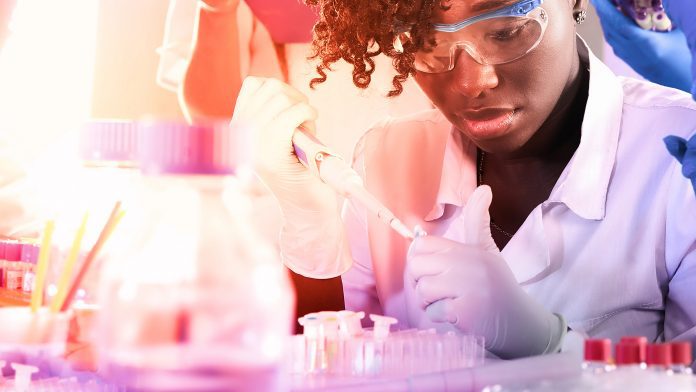
Oxford University scientists created a world-first AI diagnostic test that could dramatically improve the efficiency of viral testing. Lorna Rothery spoke to co-developer Dr Nicole Robb about how novel diagnostic technologies could improve healthcare delivery.
Rapid diagnostic tests are increasingly used as a faster, cheaper, and more accessible means of identifying infectious diseases. While reverse transcription polymerase chain reaction-based (RT-PCR) and lateral flow tests have been integral in understanding the prevalence of SARS-CoV-2, and, therefore, how to contain it, these tests are not without their limitations. Often, patients wait days before receiving their results, or immediate results are sometimes unreliable and only test for a single pathogen. Earlier this year, Oxford University scientists and Pictura Bio founders Nicolas Shiaelis and Dr Nicole Robb announced the creation of a novel universal testing platform that harnesses the power of Artificial Intelligence (AI) in diagnostic technologies to accurately identify known infectious agents, such as influenza and COVID-19, within minutes.
The advanced testing technology combines molecular labelling, computer vision and Machine Learning to create a universal diagnostic imaging platform which can rapidly recognise which pathogens are present. As part of the study, the researchers collaborated with John Radcliffe Hospital. They labelled viruses in over 200 clinical samples (such as a nasal or throat swab), which were subsequently captured and processed by their custom Machine-Learning software. The technology has proven to rapidly identify different types and strains of respiratory viruses, including flu and COVID-19, with at least 97% accuracy. Not only could such tests help to alleviate pressures on over-burdened health services. Still, they present a cost-effective, efficient method of identifying multiple pathogens quickly, simply by retraining the software.
Lorna Rothery spoke to Dr Nicole Robb about why advanced viral diagnostic tests are so integral to improving healthcare delivery and how she hopes to develop and diversify the technology for use in point-of-care and the identification of additional pathogens.
What prompted your research into advanced diagnostic testing technology?
My interest in studying viruses began at university; I subsequently decided to study influenza for my PhD and microscopy during my post-doc. I realised that with all the huge advances in microscopes, and microscopy development, coupled with the computational side – image analysis, AI etc. – we could now visualise viruses. From there came the idea that if we can see these viruses, we can also diagnose them. At Oxford, I was surrounded by a fantastic team of people, and we worked together to try and make this a reality.
My team and I collaborated with clinicians at the John Radcliffe Hospital in Oxford. They allowed us access to critical samples and to test our ideas in a hospital setting. Once we had that proof of principle, we could start developing our commercial ideas, and we were lucky to get great investors.

Rapid diagnostics are not only important for ensuring people receive the right treatment when needed, but for alerting people who are infected so they can take the necessary precautions such as self-isolating
How integral are rapid diagnostic tests in controlling the spread of respiratory infections?
Rapid diagnostic tests are crucial, and, of course, there is no better example of that than what we have seen over the last few years with COVID. Rapid diagnostics are not only important for ensuring people receive the right treatment when needed but for alerting people who are infected so they can take the necessary precautions, such as self-isolating.
The COVID-19 pandemic did, however, highlight some shortcomings regarding rapid diagnostics, for instance, having to wait for days for PCR test results or the lack of specificity associated with lateral flow tests and potentially developing symptoms before you have a clear indication of infection. There is a gap for tests that are quick, reliable, and accessible.
Why is it important that diagnostic technologies continue to evolve? What advantages does AI diagnostic testing technology offer over conventional diagnostic tests?
Diagnostic testing must evolve because we have not yet reached the perfect solution. We have advanced technology already, but there is room for improvement in its utilisation, as highlighted during the pandemic. One of the advantages of our platform is that we have universal biology, so we can see anything in the sample and then train the AI to recognise certain pathogens. Therefore, when confronted with a future pandemic, or any novel outbreak, you do not need to create an entirely new test for a different pathogen; you simply update the software on the same platform, which can take days.
It is important that tests can yield results quickly but are also easy to use. Our test features a simple cartridge where you add the sample, and everything is done for you. Our overall goal is ultimately to develop a simple test that does not require a laboratory environment.
How do you hope your findings will inform future approaches to the diagnosis and surveillance of respiratory viruses?
We hope our test will revolutionise how diagnostics are done and change the way specific illnesses are identified across different settings, be it in hospitals or community care. While there is a clear need for quick, reliable tests in acute care settings, providing tests within primary and community care can help alleviate pressure on the health system. So, if a patient feels unwell, they can take a simple test at a pharmacy and either leave with some medicine or a referral for further medical care if needed.
There is a sense of inertia to change ideas and technologies that are trusted and established, and that is one of the biggest challenges when developing new diagnostic technologies.
Which areas of healthcare do you see AI having the biggest impact in the future?
AI is used increasingly in healthcare to support clinicians, such as in MRI and CT scans or within smart devices at the patient’s bedside that can monitor vital signs. I expect we will see it incorporated more into drug design and repurposing for other diseases. In terms of diagnostics technologies, AI will hopefully make diagnostic tests more accessible, particularly in low and middle-income countries with a shortage of clinicians. Overall, I think there are limitless uses for AI, not only in healthcare but in all aspects of our lives.
Dr Nicole Robb
Visiting Lecturer
University of Oxford
Mr Nicolas Shiaelis
Graduate Student
University of Oxford
https://pictura.bio/
This article is from issue 25 of Health Europa Quarterly. Click here to get your free subscription today.
























